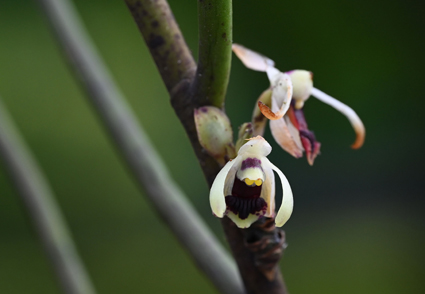Abstract
We have described and illustrated a new species, Luisia brachyota (Epidendroideae, Orchidaceae), from south Yunnan, China. Morphological comparisons indicated the new species is similar to L. filiformis and L. cordata, but differs from L. brachyota inflorescences 3-or 5-flowered, lip shorter than petals, hypochile thickly fleshy, epichile cordate adaxially with 7 or 9 papillate longitudinal ridges. Molecular analysis based on the nuclear ribosomal ITS and plastid sequences (matK, rbcL, and trnL-trnF) shows that it is a new species.
References
- Blume, C.L. (Carl Ludwig) (1849) Museum botanicum Lugduno-Batavum, sive, Stirpium exoticarum novarum vel minus cognitarum ex vivis aut siccis brevis expositio et descriptio. Lugduni Batavorum [Leiden, the Netherlands]: [s.n.], 63 pp. https://doi.org/10.5962/bhl.title.274
- Capella-Gutiérrez, S., Silla-Martínez, J.M. & Gabaldón, T. (2009) trimAl: a tool for automated alignment trimming in large-scale phylogenetic analyses. Bioinformatics 25 (15): 1972–1973. https://doi.org/10.1093/bioinformatics/btp348
- Chowdhery, H.J., (1998) Orchid Flora of Arunachal Pradesh. Bishen Singh Mahendra Pal Singh, Dehra Dun, India.
- Chen, X.Q., Liu, Z.J., Zhu, G.H., Lang, K.Y ., Ji, Z.H., Luo, Y.B., Jin, X.H., Cribb, P.J., wood, J.J., Gale, S.w., Ormerod, P., V ermeulen, J.J., wood, H.P., Clayton, D. & Bell, A. (2009) Orchidaceae. in: WU, Z.Y ., Raven, P.H. & Hong, D.Y. (Eds.) Flora of China, vol. 25. Science Press, Beijing and Missouri Botanical Garden Press, St. Louis, pp. 488–490
- Gaudichaud, C. (1829) In: Freycinet, D.L. (Ed.) Voyage autour du monde: entrepris par ordre du Roi, Botanique. Paris, Pillet Aine, 522 pp.
- Huang, J., Yu, Y.Y., Chen, G.Z., Liao, X.Y., Liu, Z.J. & Peng, D.H. (2020) Luisia yunnanensis (Orchidaceae; Epidendroideae), a new species from China: evidence from morphology and DNA analyses. Phytotaxa 475 (1): 52–58. https://doi.org/10.11646/phytotaxa.475.1.5
- Misra, S. ( 2010) A new species of Luisia Gaud. (Orchidaceae) from Andaman and Nicobar Islands, India. Nelumbo 52: 152–155.
- Noriaki, F. (1934) Studia Orchidacearum Japonicarum I Orchidaceae Formosanae Novae Atque Criticae. Botanical Magazine. [Shokubutsu-gaku zasshi]. Tokyo 48: 306. https://doi.org/10.15281/jplantres1887.48.297
- Seidenfaden, G.S. (1971) Notes on the Genus Luisia. Dansk botanisk arkiv 27 (4): 1–101.
- Tsi, Z.H., Chen, S.C., Luo, Y .B. & Zhu, G.H. (1999) Luisia. In: Flora Reipublicae Popularis sinicae, tomus 19. Science Press, Beijing.
- Xu, S.W., Gao, X.Y., Zeng, M.Y., Zhou, C.Y., Liu, Z.J. & Li, M.H. (2023) Phylogenetics of two rhizomatous epiphytic species of Cymbidium (Orchidaceae; Cymbidieae): evidence from analyses of nuclear and plastid DNA. Phytotaxa 598: 97–104. https://doi.org/10.11646/phytotaxa.598.1.8


